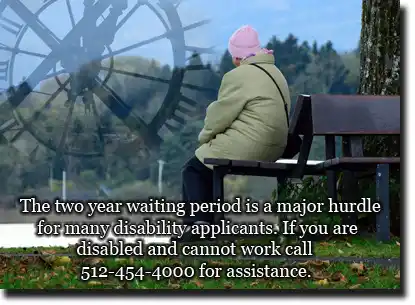Medicare- The Two Year Waiting Period
Are you wanting to enroll in Medicare after receiving Social Security Disability?
Author Attorney Lloyd Bemis:
After you have been approved for Social Security Disability Insurance, there is usually a two year waiting period before you will be eligible to receive Medicare.

Many people think that they will get Medicare upon receiving Social Security Disability benefits and are caught by surprise when they learn there is a two year waiting period.
Once you have applied and been approved for Social Security Disability Insurance, you will be eligible to receive Medicare after two years. Many people think that they will get Medicare upon receiving disability benefits and are caught by surprise when they learn there is a two year waiting period. This waiting period can seem to be arbitrary and unfair. There are rare exceptions to the waiting period- if you have End Stage Renal Disease or Lou Gehrig’s Disease- but most disability applicants will have to go without Medicare for two years. Although the waiting period can be difficult for those living through it, a look at the history and politics of Medicare reveals it was established as a money-saving compromise.
Harry S. Truman wanted to establish a national healthcare system as early as 1935.
The American Medical Association opposed his plan on the grounds that it was “socialized medicine”. If today’s heated debate over Obamacare is any indication, healthcare has long been a controversial issue in America. Under private insurance, people over the age of 65 found it difficult to find a plan that would work for them. Private insurers don’t want to take on customers who are chronically ill or have low incomes. Lyndon B. Johnson championed Truman’s ideas and Medicare began with the Social Security Amendments of 1965. Harry S. Truman and his wife were the first to be enrolled in the new Medicare program.
When Social Security began, it did not include healthcare.
It was not until the Social Security Amendments of 1972 that Medicare became part of disability insurance. At the time, it was a controversial decision. The Ways and Means Committee released a report explaining their reasoning for the waiting period. The report states the purpose of the waiting period is to keep costs down and avoid competition with private insurers. Currently, it is estimated that there 1.8 million people who are stuck in this two-year period.
There are a few options available to those in this situation:
Medicaid- Unlike Social Security Disability Insurance or Medicare, Medicaid eligibility is determined in part by financial need. Medicaid is handled by state governments rather than the federal government. Obamacare expanded Medicaid eligibility in many states, but not in Texas. To make matters worse, Texas has some of the hardest-to-meet eligibility criteria in the union. In order for an adult to receive Medicaid in Texas, they must be disabled and have a low income and limited resources. We will cover Medicaid eligibility in more detail in a future blog.
Private Insurance- Insurers are now prohibited for discriminating on the basis of pre-existing conditions so it has become easier for the disabled to find private insurance. However, the cost of private insurance is prohibitively expensive, especially for those who are unable to work.
COBRA- COBRA stands for Consolidated Omnibus Budget Reconciliation Act, and it essentially allows you to keep your employer-provided insurance after you are no longer working. The downside is your employer will no longer pay the premiums. Even worse, your premium may even go up slightly when switching to COBRA due to administrative costs. COBRA plans generally last 18 months, but can be extended if the insured is disabled.

Obamacare expanded Medicaid eligibility in many states, but not in Texas. To make matters worse, Texas has some of the hardest-to-meet eligibility criteria in the union. In order for an adult to receive Medicaid in Texas, they must be disabled and have a low income and limited resources.
Unfortunately, many people have too much income or too many assets to be eligible for Medicaid but still cannot afford to pay a premium for insurance.
Previous to the implementation of Obamacare, it was estimated that nearly a quarter of people in this two-year period go the entire period without health insurance. Clearly, if you are injured or ill enough to be unable to work, it is important to be able to afford healthcare. It is a very upsetting fact that 4 percent of those in this situation do not survive the two year wait. Having health insurance produces better health- those who spend the two year waiting period without insurance have significantly higher health costs than those who managed to stay insured. There have been proposals to eliminate the two year waiting period, but it stands in place for now.
The two-year waiting period begins on the first month you are eligible for benefits, not from your date of disability or when you actually start receiving benefits. Because many disability applicants do not actually begin receiving disability benefits on the day they become eligible, it may be less than two years between when you get your first payment and when you are eligible for Medicare. In order to determine when you will be eligible for Medicare, first determine your Established Onset of Disability (EOD), the date the SSA states your condition became disabling. Five months after the EOD will be the first month you are eligible to receive benefits, or the month of entitlement. You will be eligible for Medicare twenty-four months from that date. For example, let’s suppose you became injured January 1st, 2015. You will be eligible to receive benefits in June 2015, but will not receive Medicare until June 2017.
There are two exceptions to the two-year waiting period.
Many of the efforts to end the waiting period also focus on expanding the list of exceptions. Currently only two conditions qualify to have the waiting period waived. Applicants suffering from End-Stage Renal Disease are allowed to bypass the waiting period as the condition requires dialysis and other expensive treatments. Applicants with Lou Gehrig’s disease may also have the waiting period waived as the disease can progress very quickly with irreversible effects.

It is also possible to have the waiting period waived if you have collected disability benefits in the past.
If you had been on disability previously, returned to work and are claiming disability again for the same impairment, you will not have to wait 2 years. If you are claiming disability for a separate impairment the wait may be waived as long as it is less than 5 years after your initial claim period ended. For example, suppose you were on disability for lung cancer and then returned to work for six years. After six years of working, if you claim disability for lung cancer again, then the wait will be waived. However, if you tried to claim disability for liver disease, you would have to wait out the two years again.
The two year waiting period is a major hurdle for many disability applicants.
Being disabled by definition restricts your ability to earn a living and support yourself. It is difficult to find affordable and suitable insurance if you have a serious medical condition and are not working. Additionally, if you are not able to afford medication, the fact you are not taking it may be used as evidence against your disability claim. Because of the long waiting period, it is highly recommended you try to maintain whatever coverage you had when you became disabled.
The team of disability lawyers at Bemis, Roach & Reed knows how crucial disability benefits can be for maintaining financial stability. Our attorneys are assisting clients with their disability cases in cities all across Texas. If you are seeking disability benefits because of a sleep apnea diagnosis, contact our attorneys today at no cost to you.
Contact us today for a free consultation.
Call 512-454-4000 and get help NOW.
Try these links for further reading on this subject:
Social Security Disability, COBRA and Medicare Timeline
I Just Became Disabled – What Should I Do First?
Medicare and Social Security Disability Insurance

Your Free Initial Consultation
Call now:
At Bemis, Roach and Reed, if we can't help you, we will try to find the right attorneys for you.
We offer each of our prospective clients a free no obligation one hour phone or office consultation to see if we can help you and if you are comfortable with us. We know how difficult a time like this can be and how hard the decisions are. If we can be of assistance to you and help you find a solution to your issue we will, even if that means referring you to another attorney.
Let's get you Started:
If you could provide us with some basic information about your claim we will get right back with you with a free case evaluation and schedule your Free Consultation Today.
You can also email us at: contact@brrlaw.com
Kind Words from Our Clients
“The attorneys and staff at Bemis, Roach & Reed have provided me and my husband, Jeff, with stellar advice, care, and service. They made navigating the SSDI process easy, painless, and as timely as possible. During this difficult time in our lives it was a tremendous relief to know they were on our side and keeping us updated on next steps and timelines. We also had questions about my husband’s long term disability insurance and they helped us get those questions answered and resolved without any additional fee. I highly recommend Bemis, Roach & Reed.” – Kelli G
“I needed a lawyer for my case and had googled best lawyers. They came up first on my list and decided to give them a call. From the moment I called I knew I chose the right people. They said they would fight for me and fight they did. They knew what they were doing and kept good communication throughout the process. If you need someone that will listen, understand, and fight then these are the people. HIGHLY RECOMMEND.” – Marcel L.
“I’ve had a great experience working with Bemis, Roach & Reed for my disability case. I spent two years fighting on my own, until I was informed to look for a disability lawyer. Right away, sending in questions was a breeze, and from the moment my case was accepted, everything became a major weight off my shoulders. My newest appeal was filed for me, my medical records and case history sorted for me, and I could finally focus on my appointments and treatment with a little less worry. Everything was explained to me in a way that made sense, the process was set out in an easy to understand way. And, just like that, at the beginning of July 2023, my claim was accepted!” – Sunshinemutt






